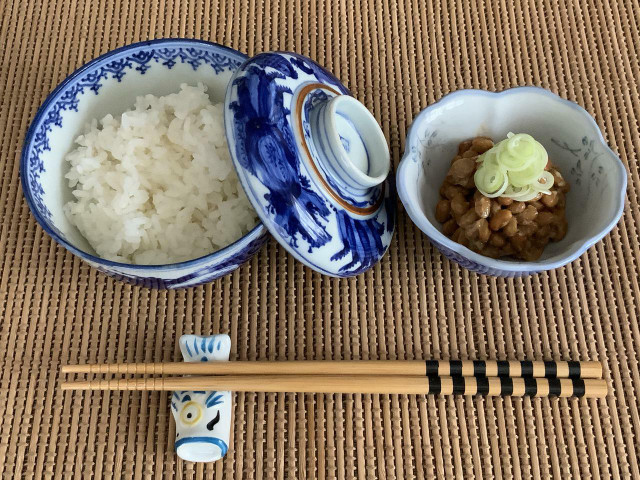Interested in how to make a tasty natto recipe at home? Japanese fermented beans are a popular dish in East Asia. Along with this recipe, you can learn the surprising benefits of natto.
The Origins of the Natto Recipe
Natto, or fermented soybeans, is a popular dish in Japan. It gains its name by being cooked with Bacillus subtilis — a broadly adapted species of bacteria found in hay, air, water, and even the intestines of humans and other animals. The dish is thought to have originated in the Yunnan province of China or the Northeast region of Japan during the 11th century.
Interestingly, the discovery may have been accidental. In the Japanese version of the story, some soybeans were boiled by a samurai called Minamoto Yoshiie. He packed them onto his horse in a rice-straw sack for a journey. During the trip, the heat coming off the body of the horse in combination with the bacteria present in the straw may have caused the beans to ferment.
In any case, when the unique taste of natto was discovered, it became a popular dish. Since then, Japanese fermented beans have been eaten widely in Japan, China, and Korea. More recently, it has gained popularity in the West.
Benefits of Japanese Fermented Beans

(Foto: CC0 / Pixabay / jcesar2015)
According to research, natto has numerous health benefits:
- Good against heart disease
- Good against diabetes
- Lowers blood pressure
- Suppresses bone degeneration
Among other things, natto is also high in vitamin K2 and protein. Vitamin K2, in particular, plays an essential role in bone metabolism. It can be a great preventative measure against osteoporosis and fractures.
Moreover, you might be surprised to learn the US is one of the largest soybean producers in the world. This means you can probably find locally sourced, certified organic soybeans near you.
But, keep in mind that an organic label doesn’t automatically mean that the product was produced by sustainable agriculture. What it does guarantee, however, is that no synthetic pesticides were used in the production and, depending on the label, that no GMO crops were used. To get the most eco-friendly beans, check out your local farms. It’s a great way to source sustainable, regional products while supporting your community.
Natto Recipe



(Foto: CC0 / Pixabay / 1737576)
With all these health benefits in mind, let’s move on to how to make some hearty natto at home.
Ingredients:
- 1 ¾ cup dry soybeans
- ¼ teaspoon natto powder without additives (available on Amazon**)
Instructions:
- Wash your dry soybeans. Impurities can affect the quality of natto fermentation.
- Place your soybeans into a bowl of lukewarm or cold water. You will need to add approximately 6 cups of water.
- Let it rest overnight till the beans expand.
- Pour the soybeans into a pressure cooker or pot. Allow to boil for 30 minutes at low to medium heat.
- Take your starter natto and add ½ a cup of boiled water.
- Mix till the natto powder is dissolved.
- When your soybeans have become tender, drain the water.
- Keep the soybeans warm by placing them on low heat.
- Slowly mix in the natto solution.
- Now the soybean and natto mix must be allowed to ferment. A yogurt maker or fermentation box works best, ideally in a warm area. They need to be stored at least 104°F for 24 hours.
- (Optional) Leave to cool in the fridge one day for extra taste.
After this, your natto is ready to eat. It can be stored in the fridge for up to two days.
Tip: check out our recipes for stinky tofu, to find more culinary delights from Asia that haven’t really caught on in the western world too much.
Natto Recipe – Without a Starter
If you’re not able to buy a natto starter in your area, fear not. You can try a few alternative methods to reap some fermented soybean goodness.
1. Self-fermenting Natto With Yogurt Maker or Fermenter
One method you could try is increasing the time the natto ferments. This allows the soybeans to create their own bacteria. Maintaining the temperature for this method can be tricky. A yogurt maker or soybean fermenter can help you with this.
Ingredients:
- 1 ¾ cup dry soybeans
Instructions:
- Wash off any impurities from the dry soybeans.
- Leave to soak for 24 hours in a bowl of water.
- Cook in a pressure cooker or high heat pot for 30 minutes or until tender.
- Remove the soybeans from the pot and drain.
- Allow the soybeans to dry out for 2 hours.
- Now place the soybeans in the yogurt maker or fermenter for 48 hours on the keep-warm function.
- You will know the natto is ready when the gooey strands appear.
If you don’t have a fermenter or yogurt maker, there is an alternative:
2. Self-fermenting Natto Without a Yogurt Maker or Fermenter
This method has been used in Northeast India. It can be expensive to buy the starter kit in some countries and this is an alternative if you want to try natto without the expense.
Ingredients:
- 1 ¾ cup dry soybeans
Instructions:
- Wash your soybeans to remove impurities.
- Add the soybeans and some water to a pot.
- Boil the soybeans on the stove at high heat for 2 hours.
- Prepare a Tupperware container by lining the bottom with a paper towel.
- Drain the water from the soybeans and spread out the beans in the container.
- Sprinkle a teaspoon of salt over the beans.
- Add another paper towel over the top of the beans.
- Leave the container slightly open. Then place it on the warmest shelf of the fridge for 3 days.
- You will know the natto is ready when the gooey strands appear.
Using Leftover Natto as a Starter



(Foto: CC0 / Pixabay / 魔理沙のズボラ飯)
If after two days you have any natto left over, you can use a previous batch to make more. This is how:
A ⅓ cup of leftover natto can be used as a substitute for the natto starter. Simply add the same amount of dry soybeans and follow the steps above. When it comes to adding the leftover natto, just stir it into your boiled soybeans and leave it to ferment. You can do this up to three times before the natto loses its fermentation power.
Serve your natto with rice and soy sauce for a traditional Japanese fermented bean meal or use it as a filling for your vegan onigiri.
Read more:
- What is Miso Paste? Origin, Production and Nutrition
- Edamame Beans: Buying, Growing, & Eating This Superfood
- Fridge Temperature and Organization: How to Store Food Properly
Important Information regarding Health-related Topics.
** Links to retailers marked with ** or underlined orange are partially partner links: If you buy here, you actively support Utopia.org, because we will receive a small part of the sales proceeds. More info.Do you like this post?







